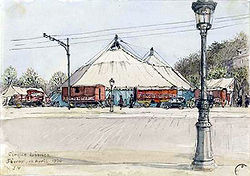Difference between revisions of "Main Page"
From Circopedia
| Line 29: | Line 29: | ||
==In The Spotlight== | ==In The Spotlight== | ||
| − | === | + | ===CIRQUE LEONCE=== |
| − | [[File: | + | [[File:Cirque_Leonce_1930.jpeg|thumb|right|250px]]The Cirque Léonce was created in 1907 (and originally called Cirque Printania) by Léonce Chapuis, a circus enthusiast from a well-to-do French provincial family, who left his sedentary life to follow a circus—the well-known and highly reputable Cirque Bureau, one of France’s oldest traveling circuses (active from c.1855 to 1953). There, he worked in the circus office as jack-of-all-trades: Someone with a high school education was enough of a rarity in the traveling circus world to be useful in a large range of administrative chores. |
| − | + | While at Cirque Bureau, Léonce trained as an acrobat on horseback, the dream he had for himself as a circus artist. Unfortunately, he broke a leg in a bad fall, and his dream came to a vanishing point. He left the circus and became a journalist, and then, probably missing show business and touring, he went on to work with the "Tournées Baret," a famous theatrical touring company. But this was not the circus. | |
| + | |||
| + | When his road crossed that of the popular Cirque Pinder (then still under the management of Arthur Pinder), Léonce asked for a job, and was hired as Régisseur—in the old French circus, a job whose fuzzy description embraced the duties of performance director, artistic administrator, stage manager, and probably, in Léonce’s case, anything that required a minimum of academic education.... ([[Cirque Léonce|more...]]) | ||
==New Biographies== | ==New Biographies== | ||
Revision as of 20:56, 1 November 2014
|
In The Spotlight
CIRQUE LEONCE
The Cirque Léonce was created in 1907 (and originally called Cirque Printania) by Léonce Chapuis, a circus enthusiast from a well-to-do French provincial family, who left his sedentary life to follow a circus—the well-known and highly reputable Cirque Bureau, one of France’s oldest traveling circuses (active from c.1855 to 1953). There, he worked in the circus office as jack-of-all-trades: Someone with a high schoolA display of equestrian dressage by a rider mounting a horse and leading it into classic moves and steps. (From the French: Haute école) education was enough of a rarity in the traveling circus world to be useful in a large range of administrative chores.While at Cirque Bureau, Léonce trained as an acrobat on horseback, the dream he had for himself as a circus artist. Unfortunately, he broke a leg in a bad fall, and his dream came to a vanishing point. He left the circus and became a journalist, and then, probably missing show business and touring, he went on to work with the "Tournées Baret," a famous theatrical touring company. But this was not the circus.
When his road crossed that of the popular Cirque Pinder (then still under the management of Arthur Pinder), Léonce asked for a job, and was hired as Régisseur—in the old French circus, a job whose fuzzy description embraced the duties of performance director, artistic administrator, stage manager, and probably, in Léonce’s case, anything that required a minimum of academic education.... (more...)
New Biographies
- Pancracio, Clown
- Circus Sarrasani, History
- Tom Dougherty, Clown
- Alfred Beautour, Cat Trainer
- Ali Hassani, Acrobat and Circus Owner
New Videos
The new videos listed below show acts that have participated in the Idol Circus Festival in Moscow in September 2014.
- Du Quan Ho, Aerial Loop (2014)
- Yuriy & Natalya Aleksandrov, Bear Act (2014)
- Duo Sharkovich, Slack Wire (2014)
- Bayramukov Troupe, Fast-Track Tumbling (2014)
- Pyongyang Flying Troupe, Flying Trapeze (2014)
- Margarita Nikulina & Vitaliy Zaets, Acrobatic Adagio (2014)
- Aliya & Andrey Kanakhin, Chinese Pole (2014)
- Nergui Duo, Contortion Act (2014)
- Vik & Fabrini, Comedy Magic (2014)
- François Borie, Juggler (2014)
- Erik Israfilov, Camel Act (2014)
- Viktoria & Oleg Aleksandrov, Dog Act (2014)
- The Fujian Acrobatic Troupe, Tumbling and Lasso (2014)
- Anastasia Evkhimenko, Hula-Hoop on Horseback (2014)
- Mikheev Trio, Ring Balancing (2014)
- Yulia Denisenko & Yuriy Khokhlov Polar Bears (2014)
- The Shatirov Troupe, Russian Barre (2014)
- The Skokov Troupe, Russian Swing (2014)
- Khamada Kuta, Lion and Tiger Act (2014)
- Veronika Teslenko, Aerial Straps (2014)
- Elena Baranenko & Elena Patrikova, Tissu Act (2014)
- Shagunin Troupe, Perch-Pole Balancing (2014)
Featured Oral Histories
- Nikolai Pavlenko, tiger trainer - Interview (RIA Novosti, 2012)
- Alberto Zoppé, Equestrian - Interview (McCutcheon & Distasio, 2003)
- Olivier Taquin, Mime - Interview (Jando, 2008)
- Barry Lubin, Clown (Grandma) - Interview (Jando, 2008)
- Fumagalli, Clown - Interview (Jando, 2008)
A Message from the Editor
CIRCOPEDIA is a constantly evolving and expanding encyclopedia of the international circus. New videos, biographies, essays, and documents are added to the site on a weekly—and sometimes daily—basis. So keep visiting us: even if today you don't find what you're looking for, it may well be here tomorrow! And if you are a serious circus scholar and spot a factual or historical inaccuracy, do not hesitate to contact us: we will definitely consider your remarks and suggestions.
- Dominique Jando
- Editor/Curator
